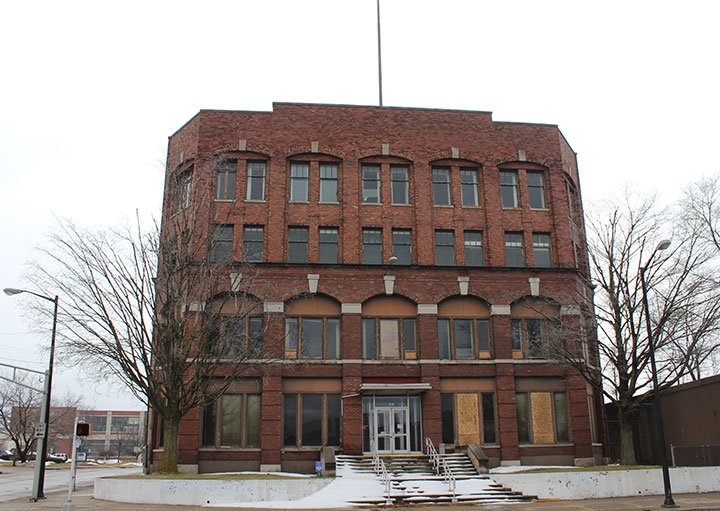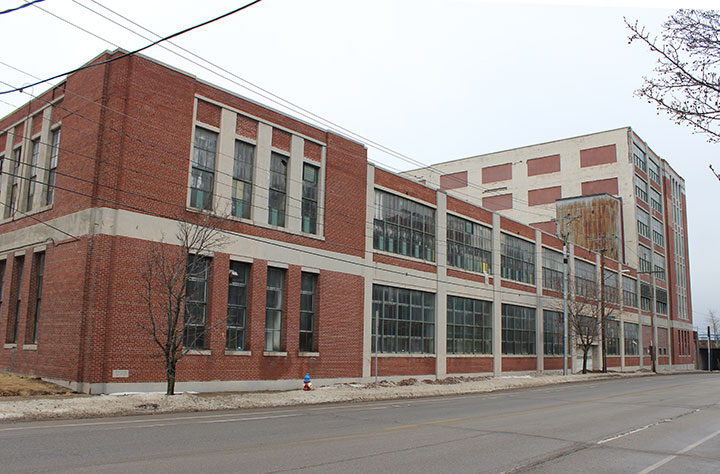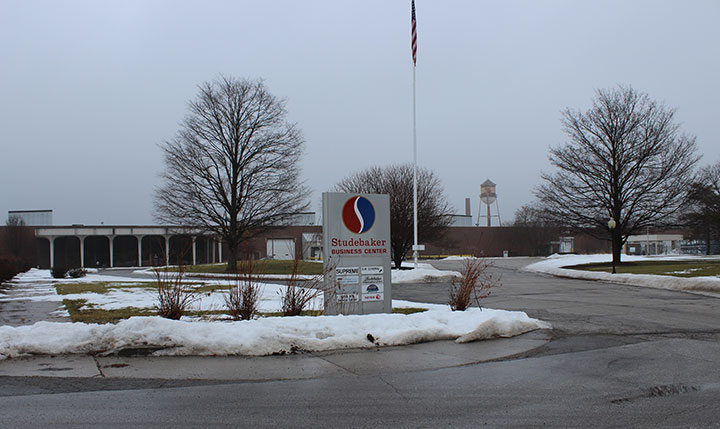|
Studebaker Main Page
Studebaker Proving Ground
Studebaker South Bend Plant Photos
Studebaker
World War Two Vehicle Photos
Studebaker in World War One
Studebaker R-1820 Aircraft
Engines on the B-17 "Yankee Lady"
Studebaker World War Two Fort Wayne
Plant
Studebaker Pacific Corporation
Studebaker South Bend Plant Photos
South Bend, IN
1852-1963
Rest in Peace
This page updated 12-25-2016.
The Main Studebaker
Complex in South Bend.

Studebaker at its peak. This photo,
looking southwest, shows the massive complex that Studebaker had during
World War Two. From these buildings came
16,089 Light Cargo Carriers and 218,863 US6 2-1/2 ton 6x6 and 6x4 trucks during the conflict. Two of the
buildings still exist, which are located to the far right, or north, and
are right up against the railroad tracks.

A US6 gets its cargo body added in February
of 1942 at the downtown South Bend Complex. Photo added 2-12-2015.

Photo added 2-12-2015.

Photo added 2-12-2015.

Photo added 2-12-2015.

M29 Weasels on the Studebaker assembly line
in South Bend, IN. Photo added 12-25-2016.

This building was the administration
building for Studebaker. Author's photo.

Before and after World War Two, the
railroad tracks immediately to the north of the building were operated
by the New York Central. It must have made for interesting times
during the summer, when the windows were open, as buildings of the time
were not air-conditioned and all of the soot, smoke and noise of the
coal fired engines drifted inside the building. Author's photo.

This is looking east from the west end of
the six story factory that still stands. It was body assembly.
The corner stone at the northeast comer of the building indicates it was
built in 1923. Today is is being used as a warehouse facility.
Author's photo.

Looking north. Author's photo.

A complete view of the remaining Studebaker
six story body assembly plant. Author's photo.

The section closest to camera was added in
1945. Author's photo.

The end of the line for Studebaker in South
Bend, IN. This 1964 Daytona was the last car produced when the
plant stopped operation on December 20, 1963. Almost 7,000 jobs
were lost. Not a Merry Christmas in South Bend in 1963.
Author's photo from the Studebaker Museum in South Bend, IN.
The Aircraft Engine Plant on Chippewa
Street on the far south side of South Bend.
In December of 1940 the US Army Air Force
issued a contract to Studebaker to build 6,500 Wright R-2600 Twin
Cyclone radial aircraft engines to be used on the new North American
B-25 medium bomber. The plant pictured below was started in
January of 1941 and completed in June of 1942. During the process
of acquiring all of the necessary for the R-2600 the order was cancelled
and the contract re-let for the Wright R-1830 engine to be used instead
on the Boeing B-17 heavy bomber. Re-tooling, Studebaker by June of
1945 produced 63,789 of the R-1830 engines and from January of 1944 was
the exclusive supplier of engines for the B-17 Flying Fortress.
After the war, Studebaker, starting with the
Korean War, reopened the plant and began making the next version of the
2-1/2 ton 6x6 military truck, the M35, designed by Reo. When
Studebaker went out of business in the US in December of 1963, the
Kaiser Jeep Corporation bought the M35 truck business and used this
plant. When American Motors purchased Kaiser Jeep, it then created
a subsidiary for the production of military products named AM General,
which continued to make the M35 on Chippewa Street and became its
headquarters location.
So while one may see M35 2-1/2 ton 6x6
vintage trucks at military collector shows and museums made by
Studebaker, Kaiser-Willys or AM General, they all were produced in the
plant, the same assembly line and for the most part, the same workers.
Only the name on the building changed.
In 1963 Studebaker was awarded a contract
for 8,493 M54A1 5 ton 6x6 trucks to also be built at Chippewa Street.
However, before trucks could come off the assembly line, Studebaker
collapsed and the contract was taken over by Kaiser Jeep. While it
is unknown how many M35 trucks Studebaker built at the plant, the
combined production for Kaiser Jeep /
AM General production was 112,000 5-ton and 150,000 2 1/2-ton trucks
before the plant closed in 1989.
Today the plant no longer makes military
trucks and is being used as a warehouse and light manufacturing facility
by several small companies. AM General has a small presence at the
location. As seen below, one can visit the site and drive all the
way around the plant.

These two buildings look to be post war
additions to the site, probably built by AM General as its headquarters
building on the left, with a security building on the right. This
is the south side of the complex. Author's photo.

Inside the entrance. The former B-17
engine plant is now known as the Studebaker Business Center.
Author's photo.

This entrance way and lobby again look to
have been added by AM General in the 1970's when it took over the plant.
Author's photo.

This is part of the west side of the
building. Author's photo.

These are engine test cells, eight total in
this bank. I counted 26 banks for 208 test cells. All 63,789
engines were hot texted for four hours, then completely torn down and
inspected for wear. If no problems were found, the parts were
cleaned and the engine reassembled and shipped. If there were
major problems, new parts would be rebuilt into the engine and a retest
run. This is the northwest corner of the plant. Author's
photo.

Looking west from the east end one can see
the entire north end of the plant consisted of engine test cells.
Author's photo.

The power house still stands. Author's
photo.

As does the water tower, which should have
had the names of three different companies on it between 1942 and 1989.
Author's photo.

Looking to the north along the east side.
Author's photo.

R-1820 aircraft engines coming down the line
in the Chippewa Street Plant. Photo added 2-12-2015.

Photo added 2-12-2015.

One of 63,789 R-1820 aircraft engines
Studebaker built for the Boeing B-17 during World War Two.
Author's photo from the Studebaker Museum in South Bend, IN.

The Studebaker ID tag on the engine.
Author's photo.

This is a 1962 Studebaker-Packard M35A1
built at Chippewa Avenue. Author's photo.

Author's photo.

Seen at the 2015 Wings over Wayne Airshow at
Seymour Johnson AFB is this 1965 Kaiser M35A2 built in the Chippewa
plant. Its last known assignment was with the 810th Medical
Company (Dental) in Cary, NC. This is an Army Reserve unit.
Author's photo added 5-27-2015.

Here is a 1973 AM General M35A2 that came off the Chippewa plant
assembly line. Author's photo from the National Center Military
History in Auburn, IN.
|





























